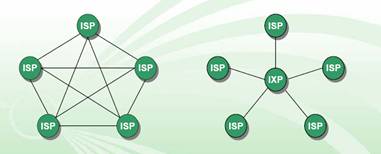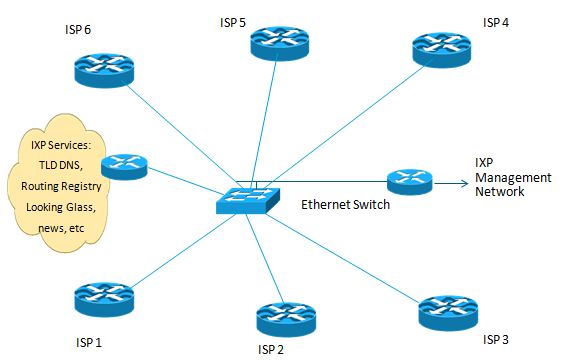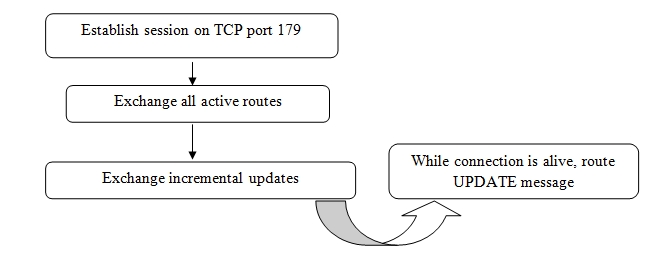The Internet consists of a plethora of networks (public, private, government etc.) which carry an abundant range of information, services and resources and connect to each other via bundles of data called packets. Everything that we use in our daily lives such as E-mail, Search Engines, VoIP, Peer-to-Peer file sharing are a result of the transference of these data packets. Shipping packets around the world involves cooperation between different organizations and can be quite challenging. Packets can also be lost during transmission due to the distance, collision or excessive crowding. This packet transfer across the Internet is made easier by Internet eXchange Points (IXP) where local networks efficiently exchange information at a common point within a country. At an IXP, Internet Service Providers (ISPs) exchange traffic using high speed network/Ethernet switch. An Internet Service Provider is a company or organization that provides web access to its clients by maintaining a direct line to the internet and web servers. AT&T, Hathway, Verizon, Bharti Airtel, Sify are some well-known Internet Service Providers.

Fig. 1: Image Showing ISP Scenario With and Without IXP
The above figure depicts the ISP scenario both without an IXP and with an IXP. In case of an IXP, every ISP has to buy just one whole circuit from their ISP to the IXP instead of several half circuits to every other ISP. This removes the complexity of direct one-to-one connections between ISPs as well as reducing the cost for further connections. Through the IXP, traffic is exchanged locally within the country rather than using the local Internet traffic overseas. This saves international bandwidth which can be used for backup or international traffic. A comprehensive layout of the Internet hierarchy is shown below.

Fig. 2: Image Showing Comprehensive Heirarchy of Internet
IXP Architecture
There are usually two kinds of IXP architectures: Layer2 and Layer3. In Layer 2 (L2), all the ISPs are interconnected using Ethernet switch whereas in Layer 3 (L3), all the ISPs are interconnected using a router. Layer 3 is not widely used as it is router based and thus was overwhelmed by the rapid growth of the Internet. Today, it is merely a marketing concept used by Transit ISPs. Layer 2 topology uses a common network medium like Ethernet (100 Mbps/1 Gbps/10 Gbps/100 Gbps technologies) which is connected to neighbouring ISPs. Members bring their own routers and circuits from their backbone and they are free to set up peering agreements with each other as they wish. All traffic is exchanged outside routers that are connected to a shared media (Ethernet switch).

Fig. 3: Diagram Showing IXP Architecture
A Layer 2 IXP has a proven upgrade path with a simplistic design. Also, it can scale up to 60 IXP members with low cost entry for its participants. Services are offered such as Search engines, Internet portal, DNS Root, Looking Glass etc. ISPs also use two switches for load-sharing or redundancy. In a Layer 2 exchange, each member has to peer with every other member as part of their IXP membership. This is called Mandatory Multi-lateral Peering.
Peering at an IXP using BGP
Peering at an IXP using BGP
An ISP can exchange traffic with any of the other ISPs through the IXP switch (public peering) or directly by having a physical interconnection (private peering). Peering between ISPs requires exchange of routes used between Autonomous Systems (AS). Autonomous Systems (AS) are independently run networks or a set of related networks, some being commercial ISPs which come under one administrative domain. For successful peering, the ISP router needs to be able to run BGP, an Ethernet port to connect to the IXP switch and a WAN port to connect to the ISP backbone’s WAN media. The peering is done through the Border Gateway Protocol (BGP) which is basically a path vector routing protocol that exchanges routes for IP address ranges or prefixes.

Fig. 4: Image Showing Peering at IXP with BGP
The BGP routes between domains and unifies network organizations while helping in choosing the best route by using preferences local to AS and AS path length. As a BGP route travels from AS to AS, the AS number of each AS is stamped on it when it leaves that AS which is called the AS-path. IXPs themselves do not require Autonomous System Numbers (ASN) as the Ethernet switch does not run BGP, but the services run by the IXP requires a transit router that needs a Public ASN and Address space as well. ASNs make it easier for the BGP to route through IXP traffic. Each participating ISP in an IXP needs to run BGP for peering to take place as external BGP configures directly with other participants in the IXP. The BGP operation is shown below.

Fig. 5: Block Diagram Showing BGP Operation
Case Study of NIXI


Fig. 7: Obtaining Output a Standard Output from NIXI Site
The individual parameters of the command output are as follows:

The command output also contains a table towards the end; the columns of the table are further elaborated below:

Filed Under: Articles


Questions related to this article?
👉Ask and discuss on Electro-Tech-Online.com and EDAboard.com forums.
Tell Us What You Think!!
You must be logged in to post a comment.